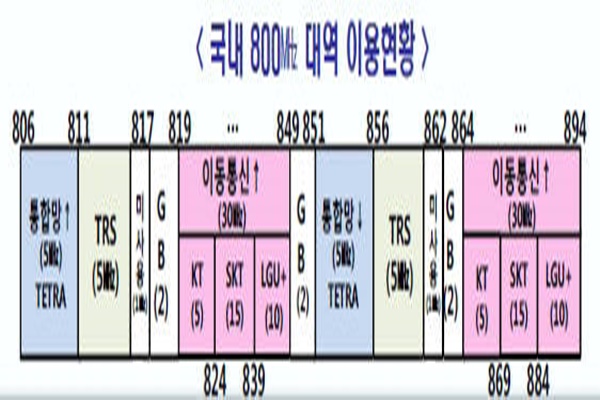Ministry of Science, ICP and Future Planning (MSIP) is going to collect bandwidth of 800 MHz National Convergence Network (Frequency Common Communication TRS method), which is used by railroads, police departments, and fire departments, by 2018 and use it for mobile communication or IoT80. Its goal is to solve increase of communication traffic and reduce construction cost of National Public Safety-LTE, and it seems that establishment of Railroad Convergence Network (LTE48-R) will also speed up.
According to communication industry, MSIP recently held a meeting for industries to efficiently use public institutions’ frequencies such as 800 MHz National Convergence Network, Very High Frequency (VHF), Ultra High Frequency (UHF), and others. This was held to listen to opinions from different industries following a presentation that was held in last July.
MSIP decided to collect 800 MHz National Convergence Network and VHF and UHF bandwidths, which are used in low-frequency bandwidth, by 2018. Public institutions such as railroads, fire departments, police departments, and others use 800 MHz 10 MHz range (806~811 MHz, 851~856 MHz) for National Convergence Network. As corresponding bandwidths were converged to 700 MHz that was assigned to become National Public Safety-LTE, MSIP has been examining ways to improve efficiency of frequency uses.
By voicing opinions that it will be a waste of money since it has not been that long that current communication equipment such as Terrestrial Trunked Ratio was established, some institutions complained that it will be hard for them to return frequency by 2018 as MSIP decided. Excluding a line that goes from East Daegu to Busan and Honam Line that still have life expectancies, MSIP ordered that Railroad Convergence Network (LTE48-R) that uses 700 MHz to be built at most of subways, city railroads, and express railroads.

It is planning to confirm and notify its plan of frequency use to most institutions at end of this year excluding some railroad lines. A reason why it chose year 2018 as a time to collect bandwidth by is because establishment of National Public Safety-LTE (2017 and time of stabilization will be around 2018.
“We are currently gathering opinions from different institutions since there can be issues about budget and life expectancies of current equipment. We are going to work hard so that 800 MHz National Convergence Network can be changed to 700 MHz National Public Safety-LTE early as possible.” said one person that is associated with MSIP’s Frequency Policy Department.
A reason why MSIP is trying to take care of this matter as soon as possible is due to railroads. If railroads establish LTE-R within 700 MHz bandwidth, cost of establishing National Public Safety-LTE will be decreased and it will be easier to establish national network. It also had a close meeting with Ministry of Public Safety and Security regarding this matter.
Most of railroad institutions already returned corresponding bandwidths and are planning to install LTE-R that uses 700 MHz bandwidth by 2018. Pusan Subway already established LTE-R, and Daegok-Sosa Line, Sosa-Wonsi Line, Kimpo City Railroad, and others are also considering about introduction of LTE-R.
“MSIP’s will to modify 800 MHz frequency is firm. Excluding couple sections that already started establishment through current Trunked Radio Service, rest of sections need to establish LTE-R by 2018.” said Kim Yong Kyu who is the head in Korea Railroad Research Institute.
Staff Reporter An, Hochun | hcan@etnews.com